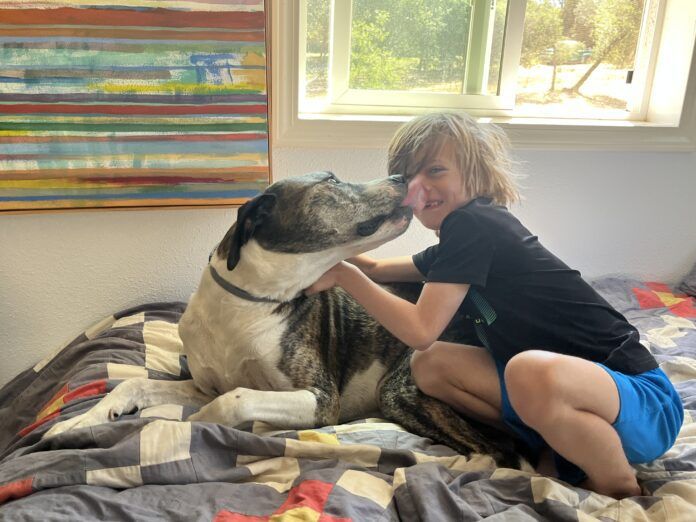The difficulty and importance of supervising kids and dogs.
We’ve had lots of articles in WDJ about kids and dogs: choosing when to get a dog “for the kids,” the importance of supervision and management, training the kids, managing them together, and more. When I’m writing or editing these articles, I’m usually using my memory of my son’s childhood with dogs (Eli is 31 years old now!) as a guide to what is necessary and practical.
When my son was born, I had a very shy and somewhat fearful Border Collie named Rupert, who was not thrilled with the addition of a screaming human infant to our family. I worked to desensitize and counter-condition Rupert to baby sounds that he found distressing, and we did OK for some months . . . but when Eli started walking at just 10 months old, I had to employ baby gates all over the house to keep Rupert and Eli separated when I couldn’t actively supervise them. I was a single mom; I couldn’t be everywhere at once.
And I mean actively, because here is a recipe for disaster: Take one very active though wobbly 10-month-old baby, and one very active and sensitive Border Collie, and do not mix them alone together ever! Because it takes just a second for something bad to happen – or, in my case, almost happen.
When Eli was just about 18 months, I was unloading all of us and a bag of groceries out of the car, home after a long day at work. I was the part-owner of a horse magazine at the time, and both Rupert and Eli came to work with me every day (we had baby gates all over the office, too). I let Rupe jump out of the “way back” of the car, took Eli out of his car seat and set him on the ground, turned back to the car to grab the bag of groceries – and when I turned around, I saw the closest near-miss of a face-bite that I’ve ever seen. Rupert was standing near me when Eli took a step and stumbled, falling toward the Border Collie with open hands, grabbing handfuls of fur as he fell. And Rupert snapped at Eli’s face as he whirled away from the falling toddler. I was RIGHT THERE and if Rupert had chosen to make contact with my baby’s face, he certainly could have scarred him for life.
Eli was fine and the dog was fine, but I burst into tears. I realized in that moment that I had too much on my plate to single-handedly manage the dog and the toddler – and a young business only on the verge of solvency, requiring long hours of work every week). I called my mom and asked if she and my dad could take Rupert in for a while. Rupe ended up living with them for about a year and a half, until Eli was more steady on his feet and could listen to instructions, and I had things more under control.
Why am I talking about all of this now, 30 years later? Because, like many grandparents, I am reliving the kid/dog challenge at the moment.
My husband’s two adult children have three sons between them. The 11-year-old grandson stays with us for a time every summer, so he’s familiar to my dogs – but he also doesn’t love dogs. He likes them OK, he’ll gently pat one once in a while, he expresses momentary curiosity about any foster puppies I have, but he would not miss any of the dogs if they were not here. And he absolutely does not interact with them on his own; he’s just not interested.
But the 7-year-old grandson has never spent time with us here until this summer; he’s with us for 10 days. This kid loves, loves, loves dogs – and that’s actually more of a problem than a kid who does not love dogs, because he is trying to hug and kiss and gaze into the eyes of my two dogs every chance he gets. He wants to run alongside them, use them for pillows on the couch, lay on their beds with them, feed them every meal and treat, boss them around, and sleep with them on his bed.
Thank dog for Uncle Woody, my 7-year-old Pit Bull-mix. He loves, loves, loves kids, and (so far) hasn’t seemed to mind all of this adulation too much. He has also never minded human touch of any kind; he’s fine with being used as a pillow, you can move him or mold him to help you fit better together on a couch, and he doesn’t even mind investigations of his silky ears, loose lips, or paw pads. He’s always mindful of his big, strong body, and hasn’t knocked over a kid yet (although he’s given me plenty of bruises while roughhousing!). His main defense when the 7-year-old gets too intimate is to ply the kid with face licks – long, extravagant swoops of the tongue, all over his mouth, nose, eyes, and ears. Woody completely understands that this puppy is just a love-bug like himself, albeit one with a dirty face.
But I have two dogs. And the second one is not as much of a fan.
Boone is about a year and a half old. According to the results of his mixed-breed DNA tests, he, too, is a Pit Bull-mix (about 60% American Pit Bull Terrier!) – though I don’t think anyone on earth would guess that from looking at him. But he’s only lived through one summer with one kid present (the now-11-year-old, who doesn’t really interact with dogs). So Boone is not sure what to make of this smaller, adoring and affectionate boy, whose hands are always reaching for him, who constantly tries to smooth the hair away from his eyes so he can look deeply into them. Boone is both pleased and excited by the attention and a little leery of being touched by the youngster. He finds those prying little hands annoying – and a couple of times, I’ve heard him growl at the boy.
And I’m thrilled to hear him growl.
Why on earth?
Because a growl gives both the boy and me information. It lets us know that whatever the boy is doing is making Boone uncomfortable. It lets me know that I need to take immediate steps to keep both of them safe and take steps later to build Boone’s comfort with being in close proximity to the boy. We never punish a growl, because if we do so, we risk losing that early warning that tells us that the dog is uncomfortable. A sog who has been punished for growling may learn to skip growling to avoid being punished for it, but under increasing pressure from a kid, will just go straight to a bite. We do not want to suppress growls; we want all the warning signals we can have.

And while a 7-year-old boy may or may not know what to do when he hears this message, I do, and I can educate the boy: It means to give the dog some room, to back away from the dog, and think about what just happened, so we can make sure not to put the dog through that again. I ask, “What were you doing before Boone growled, do you remember? Were you touching him? Looking at him? Did he have a toy in his mouth?” When I have the answers, we talk it over: “Hey, Boone’s feet are really, really ticklish and he does not want you to touch them. He doesn’t laugh when he gets tickled, he gets mad – and when dogs get mad, they might bite. Can you make sure not to touch his feet anymore?”
Boone doesn’t get punished, but he receives some instruction, too. Dogs don’t get to decide who they share the couch with; humans have more rights to the couches than dogs do. So when Boone growls, he gets asked to hop off the couch – and when he does, he’s told, “Yes! Good boy!” He gets to accompany me into the kitchen for some treats, and he gets a few more when he complies with my request to lay on a new resting spot, such as the dog bed or the couch without a boy on it. In this way, we build the attractiveness of Boone’s option to hop off the couch any time the boy is bothering him – and any time he volunteers to leave, I’m going to jump up and get him some treats to reinforce his brilliant idea.
So, decades after first learning about kids and dogs, I’m back to managing and separating – though, happily, I can tell the kid what to do and not to do with the dogs and he’s compliant. In contrast, babies and toddlers can’t (and shouldn’t) be counted on to remember and follow rules such as, “Let the dogs finish their dinner alone!” I don’t need baby gates – but when I’m not able to supervise their interactions, I have been keeping Boone with me or locked in my office. And even with this minor concern, it’s been a huge pleasure to help educate both the youngsters about each other’s species.







Thank you very much for sharing your thoughts and experiences. My husband and I will have 5 grandchildren under the age of four by Christmas and we also have a four year old mini Aussie and a four month old mini Aussie. We will have many visits in the future and I certainly don’t want anything to happen to our dogs or our grandchildren. This article gives me a chance to act proactively, protecting everybody and hopefully creating positive learning experiences.